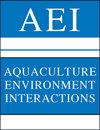Dissolved organic carbon from cultured kelp Saccharina japonica: production, bioavailability, and bacterial degradation rates
IF 2.5
2区 农林科学
Q2 FISHERIES
引用次数: 15
Abstract
Seaweed farming is widely perceived as one of the most environmentally benign types of aquaculture activity. In the past 10 yr, global seaweed production has doubled and reached 31.8 million t. Farmed seaweed also has important functions in local ecosystems. We focus on the production, bioavailability, and bacterial degradation rates of dissolved organic carbon (DOC) from cultured kelp Saccharina japonica. Semi in situ incubations in 2 growing seasons were conducted to estimate DOC production, and laboratory incubations were used to determine bioavailability and decay rates of DOC from cultured kelp. Results showed that DOC production was 6.2-7.0 mg C (g dry wt)-1 d-1 in the growing seasons, and the proportion of DOC in net primary production was 23.7-39.1%. The decomposition rate of DOC was 4 ± 1% d-1 and 9 ± 1% d-1 in January and April, respectively. About 37.8% remained as refractory DOC after 150 d incubation. It was calculated that the total DOC from kelp in Sanggou Bay was approximately 11.3 times of that from phytoplankton for the whole bay (144 km2). Our results suggest that more than half of the bioavailable DOC will be exported out of the bay to potentially support the wider food chain through bacterial uptake. Cultured kelp is therefore an important source of DOC in the embayment, contributes to the coastal DOC pool and provides a potential pathway for carbon dioxide sequestration.从培养海带Saccharina japonica提取的溶解有机碳:产量、生物利用度和细菌降解率
海藻养殖被广泛认为是最环保的水产养殖活动之一。在过去10年中,全球海藻产量翻了一番,达到3180万吨。养殖海藻在当地生态系统中也具有重要功能。我们主要研究了海藻Saccharina japonica中溶解有机碳(DOC)的生产、生物利用度和细菌降解率。通过2个生长季节的半原位孵育来估计DOC的产量,并通过实验室孵育来确定培养海带中DOC的生物利用度和腐烂率。结果表明:生长季DOC产量为6.2 ~ 7.0 mg C (g dry wt)-1 d-1, DOC占净初级产量的比例为23.7 ~ 39.1%。1月和4月DOC分解率分别为4±1% d-1和9±1% d-1。150d后仍有37.8%为难治性DOC。结果表明,桑沟湾整个海湾(144 km2)海带总DOC约为浮游植物总DOC的11.3倍。我们的研究结果表明,超过一半的生物可利用DOC将通过细菌吸收出口到海湾外,可能支持更广泛的食物链。因此,养殖海带是海湾DOC的重要来源,有助于海岸DOC池的形成,并提供了一种潜在的二氧化碳封存途径。
本文章由计算机程序翻译,如有差异,请以英文原文为准。
求助全文
约1分钟内获得全文
求助全文
来源期刊

Aquaculture Environment Interactions
FISHERIES-MARINE & FRESHWATER BIOLOGY
CiteScore
4.90
自引率
13.60%
发文量
15
审稿时长
>12 weeks
期刊介绍:
AEI presents rigorously refereed and carefully selected Research Articles, Reviews and Notes, as well as Comments/Reply Comments (for details see MEPS 228:1), Theme Sections and Opinion Pieces. For details consult the Guidelines for Authors. Papers may be concerned with interactions between aquaculture and the environment from local to ecosystem scales, at all levels of organisation and investigation. Areas covered include:
-Pollution and nutrient inputs; bio-accumulation and impacts of chemical compounds used in aquaculture.
-Effects on benthic and pelagic assemblages or processes that are related to aquaculture activities.
-Interactions of wild fauna (invertebrates, fishes, birds, mammals) with aquaculture activities; genetic impacts on wild populations.
-Parasite and pathogen interactions between farmed and wild stocks.
-Comparisons of the environmental effects of traditional and organic aquaculture.
-Introductions of alien species; escape and intentional releases (seeding) of cultured organisms into the wild.
-Effects of capture-based aquaculture (ranching).
-Interactions of aquaculture installations with biofouling organisms and consequences of biofouling control measures.
-Integrated multi-trophic aquaculture; comparisons of re-circulation and ‘open’ systems.
-Effects of climate change and environmental variability on aquaculture activities.
-Modelling of aquaculture–environment interactions; assessment of carrying capacity.
-Interactions between aquaculture and other industries (e.g. tourism, fisheries, transport).
-Policy and practice of aquaculture regulation directed towards environmental management; site selection, spatial planning, Integrated Coastal Zone Management, and eco-ethics.
 求助内容:
求助内容: 应助结果提醒方式:
应助结果提醒方式:


